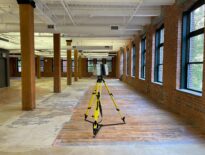Tim Curran
CEO, Building Engines
Age: 55
Industry experience: 21 years
JLL’s recent $300 million acquisition of Boston-based proptech company Building Engines brings together one of the world’s largest brokerages and a leading provider of building data and operations programs. Tim Curran joined Boston-based Building Engines in 2017 as CEO and has overseen its growth and the rollout of new features such as building access control and tenant experience. The company currently provides building management software to more than 35,000 buildings, including properties owned by major developers such as Beacon Capital and SL Green.
Q: How did your career path lead to the leadership position at Building Engines?
A: My entire career is in software. I started as a developer in the 1980s, and spent most of my career in real estate tech and proptech including construction and operations. I met the founder [of Building Engines’ in 2005 as a fellow CEO in Boston, and we hit it off and formed a small CEO group, and then in 2010 I joined the board of directors. We took on private equity to accelerate our vision in 2016, and we accelerated product development and also upped our game in the executive team area. I took over [as CEO] right after the private equity came in. I’m a hired CEO and I get hired to scale companies. We bypassed the venture capital and by 2015, we were self-sustaining and growing organically. Our revenues were at a good level and it was a growth-stage investment.
Q: What are some of the recent product development milestones?
A: With that capital, we spent an enormous amount on R&D and we replatformed our solution. We had built the leading solution for building operations, but it was 15 years old. We decided the opportunity was enormous to be a global player in building operations and real estate, and we decided to build the next-generation platform. We launched the new platform, Prism, about a year-and-a-half ago. We have not only the industry’s leading platform of functionality, but we also have the most technically advanced platform on the planet. The second thing we did is we went from being a one-product company to having a dozen products.
Q: How does the acquisition by JLL affect the company’s future growth?
A: There’s basically a complete overlay of mission between JLL and Building Engines. They saw the same opportunities. With the acquisition, we accelerated even faster. Through their venture capital fund Spark, they are investing in proptech companies and many of those are aligned with Building Engines’ market space. We cater to building owners and operators, and they had already made investments in owner-operator products that were on our roadmap. Once we did the acquisition, we quickly got into the tenant experience marketspace, the building access marketspace, and a few others. Energy management and sustainability, ESG [environmental, social and governance]: those are the three big ones we’re going to be bringing out in 2022.
Q: How can Building Engines contribute to a building’s sustainability?
A: Honestly, 10 years ago it just wasn’t a top priority for commercial real estate. The forces are regulations and different targets. The financiers of real estate are really focusing on this and they are going to lend to green sustainable buildings over brown. We’ve wanted to get into energy management for a long time. It’s a natural extension of building operations: tracking the amount of energy you’re using on a weekly or monthly basis. You’ve got to measure to manage. And then number two, once you have the data, you’ve got to find ways to reduce energy. The first product is HVAC and air handling. We have a solution through an acquisition that JLL did [in January] called HANK. It’s an energy-reduction solution powered by AI. It’s collecting massive data points from the HVAC system and figuring out how to optimize the heating and cooling of the building so tenants are comfortable and you’re lowering the energy usage and carbon footprint. The trick is not to be heating and cooling areas that don’t need to be heated and cooled: sensing what spaces people are in.
Q: How does Building Engines’ financial arrangement work with clients?
A: It’s a standard software subscription process, with an annual subscription fee. You pay for what you use. You can bundle the products that make sense for your real estate.
Q: What’s the current breakdown of clients by property type?
A: Office buildings is the biggest component, approximately 3.5 billion square feet at between 35,000 and 40,000 buildings. About 50 percent is office buildings, and the other 50 percent is split between retail and distribution and warehouse, which is a growing segment.
Q: How will JLL integrate Building Engines into its own property management offerings?
A: They were already one of our top customers, so that had picked us as their preferred platform two or three years ago. We’re certainly going to be able to drive adoption more quickly. Now we have a global platform. They manage billions of square feet around the world, so we’re going to see adoption grow faster than it was.
Q: What are the benefits in cost savings and improved financial performance?
A: We have case studies where a 25 to 30 percent reduction in operating costs is pretty typical for a building. Our customers care about net operating income: revenues minus expenses. We reduce expenses. On the revenue side, the key is to provide a premium building and be able to collect high rents. We’re seeing tenant experience rise when you use Building Engines and that equates to the quality of the product.
Curran’s Five Favorite Golf Courses He’s Played With His Son Jackson
- Pebble Beach
- Whistling Straits
- Pinehurst No 2
- Bethpage Black
- Kapalua (Plantation)







